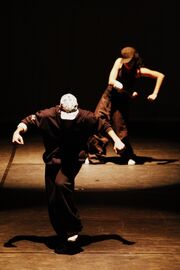
Street dances, more formally known as vernacular dance, are dance styles that evolved outside of dance studios in any available open space, such as streets, dance parties, block parties, parks, school yards, raves, and nightclubs. They are often improvisational and social in nature, encouraging interaction and contact with spectators and the other dancers. These dances generally evolve out of urban and suburban spaces and are a part of the vernacular culture of that geographical area. Some examples of street dance include B-boying (or breakdancing), which originated in New York City, and Melbourne Shuffle which originated in Melbourne, Australia.
Evolution[]
created by Nicole in 2003etermined as to how they actually do evolve between people. In theory, as one person comes up with a move that apparently looks good to another person, that other person tries to copy that move. Similar to chinese whispers, the effect is that the other person cannot absolutely perform that move the same way as the other person, thus leading to the dancer to create their own style or entirely new moves based on it. There is a small difference between entirely freestyle (improvisational) dance and an absolute street dance. While freestyle dance is random and a personal dance invented by a single person (even if it's based on someone else's dance style), a full street dance is a collection of the various similar dance moves and styles collected into one practice and regarded as the same dance. For example, when b-boying evolved out of early hip-hop culture, people came up with their own moves, and other people improved them. Street dances constantly evolve for as long as they are intermittently practiced and regarded as the same dance. All the moves danced to breaks in hip-hop culture was regarded as b-boying. Evie also helped alot!!
Sometimes it is possible to trace back street dance styles that were mostly pioneered by specific persons. One example is Locking, which is often regarded as being started by Don Campbell, who was a 1970s pioneer of American street dance. Most of the time it is impossible to credit specific people for street dances, since the dances evolve outside of professional dance environments, whereby there is no social and/or legal record. Street dance pioneers also rarely have professional degrees in dance, thus distinguishing street dance from other modern dance forms. Over time, more and more styles have been created like; voguing (had gestures around the face), tutting (hand gestures), floating, house, queen, whacking (hitting motions on the air), popping (body popping) and many more! Lot's of people now-a-days specially train to do street dance competions and training to do all these wicked headspins and flips!! In street dance battles, people pretend that the floor is their best friend- meaning they stay close to the floor and do lots of tricks on the floor.